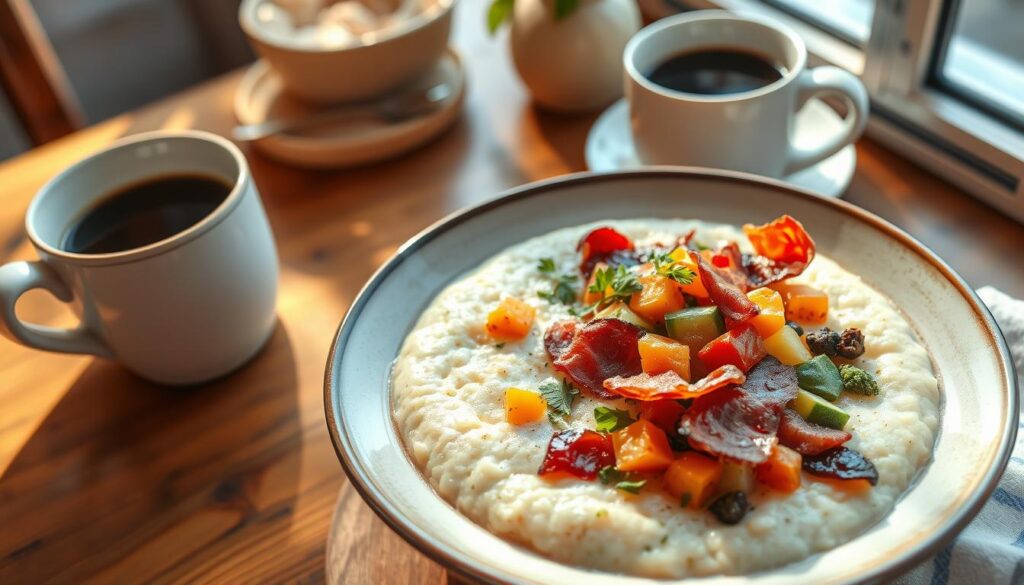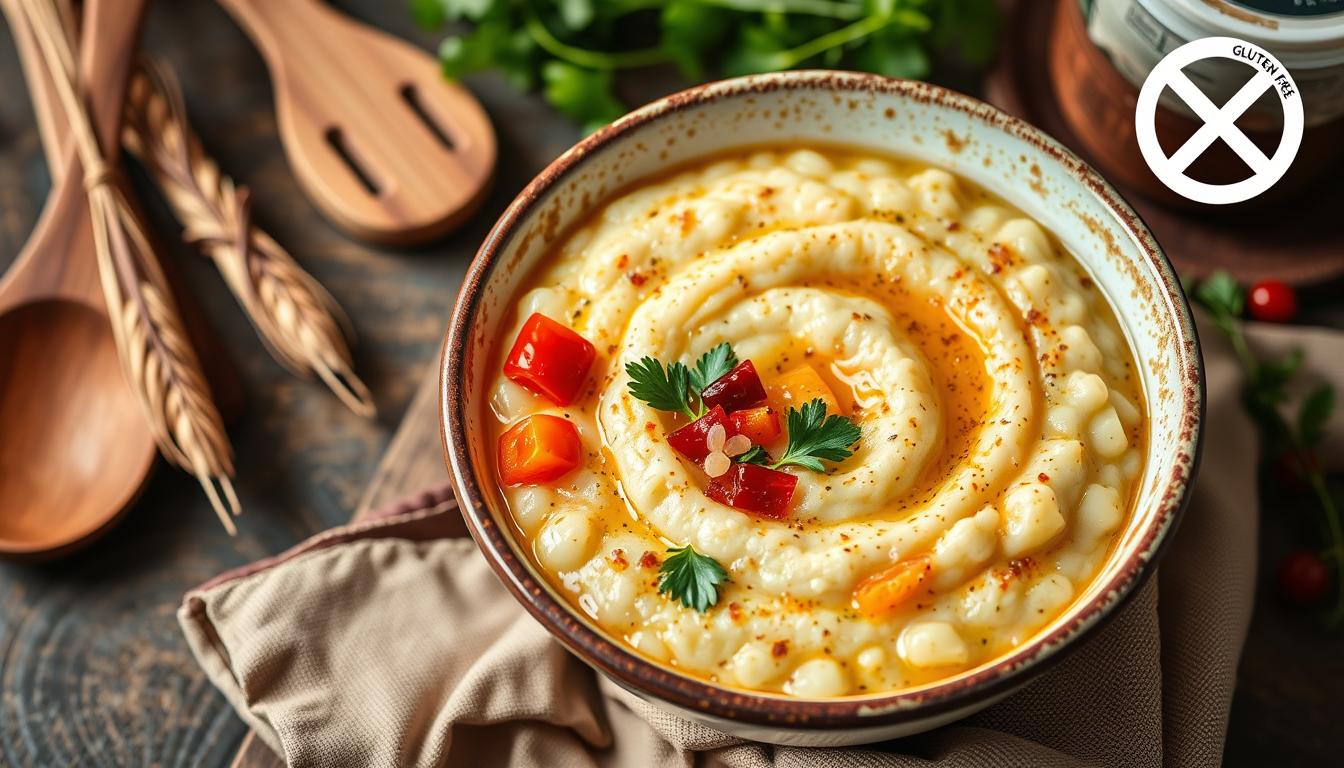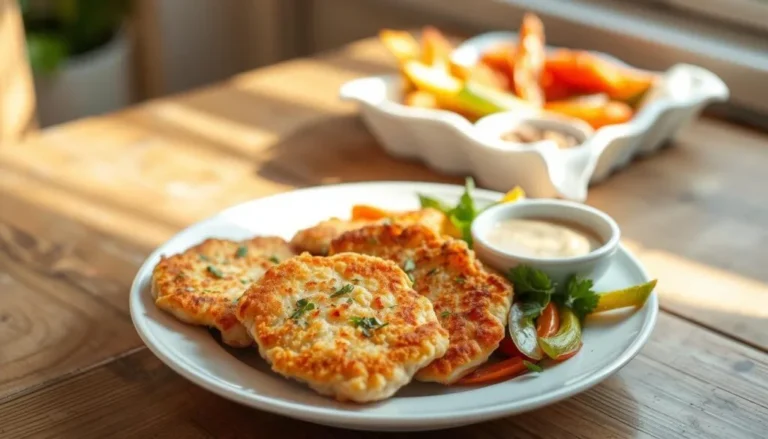Is Grits Gluten Free? A Quick Guide for Gluten-Free Diets
Growing up in the South, I never thought my favorite breakfast could cause confusion. Grits have been a comfort food for many. But for those on gluten-free diets, the big question is: is grits gluten free? Knowing the truth about grits can change your meal plan for the better.
If you have celiac disease or just want to try gluten-free foods, this guide is for you. We’ll cover everything about grits and gluten. Grits are usually made from corn, which is naturally gluten free. But, how they’re made can still pose risks.
Ready to enjoy safe, tasty grits? We’ll explore the ingredients, how they’re made, and what to watch out for. This will help you confidently say: are grits gluten free?
Table of Contents
Understanding Grits: Basic Ingredients and Production
Grits are a favorite in Southern cooking, made from corn. Knowing if grits have gluten is important. Corn is naturally gluten-free, which is good news for those watching their gluten intake.
Traditional Ingredients in Grits
The main ingredients in traditional grits are:
- Dried corn kernels (usually white or yellow corn)
- Water
- Salt (optional)
“Grits are a pure, straightforward food with roots deep in Southern culinary traditions” – Southern Cooking Experts
How Grits Are Processed
Turning whole corn into grits involves several steps. Here’s how it’s done:
- Harvesting mature corn
- Removing kernel shells
- Grinding corn into coarse meal
- Sifting to achieve consistent texture
Different Types of Grits Available
When wondering if grits have gluten, you’ll find different types. Each might affect gluten exposure differently:
- Stone-ground grits: Traditional method, minimal processing
- Quick grits: More refined, faster cooking
- Instant grits: Most processed variety
Every type starts with gluten-free corn. Knowing this helps you make better food choices.
Are Grits Gluten Free: The Definitive Answer
Wondering if there’s gluten in grits? The answer is good news for many. Traditional corn grits are naturally gluten-free. This makes them safe for those with gluten sensitivities or celiac disease.
To understand if grits have gluten, we need to look at their main ingredients. Corn, the main part of grits, is naturally gluten-free. This means that in their purest form, grits are safe for gluten-free diets.
“Pure corn grits offer a tasty gluten-free substitute for wheat-based products.” – Nutrition Experts
But, not all grits are the same. There are risks of gluten contamination:
- Check packaging for certified gluten-free labels
- Verify manufacturing processes
- Watch for added ingredients that might contain gluten
- Be cautious of flavored or processed grit varieties
To keep your grits gluten-free, always read labels carefully. Choose brands that say they are gluten-free. Some manufacturers might process grits in facilities that handle wheat. This can lead to cross-contamination.
Cross-Contamination Risks in Grits Processing
When looking into gluten free grits, it’s key to know about cross-contamination risks. This is especially important for those with gluten sensitivities. The way grits are made can sometimes mix them with gluten, which is bad for people with celiac disease or gluten intolerance.
Manufacturing Facilities and Shared Equipment
Many places that make grits also work on other grains. This means there’s a higher chance of cross-contamination. Equipment used for wheat can spread gluten particles, making your grits not gluten-free.
- Equipment used for wheat products might contaminate grits
- Milling and packaging processes can introduce gluten traces
- Small processing facilities often handle multiple grain types
Importance of Certified Gluten-Free Labels
Certified gluten free labels are very important for buyers. They show that the product has been tested and made in a way that keeps it safe from gluten.
| Label Type | Verification Level | Recommended Safety |
|---|---|---|
| GFCO Certified | Strict Testing | Highest Safety |
| FDA Compliant | Standard Testing | Moderate Safety |
| No Certification | No Testing | Potential Risk |
Prevention Tips for Consumers
To avoid gluten, you need to be careful with the grits you buy. Always check the labels and pick brands that are clearly gluten-free.
- Purchase only certified gluten free grits
- Check manufacturing facility information
- Contact manufacturers with specific questions
- Use separate cooking utensils at home
“Knowledge is your best defense against accidental gluten exposure” – Celiac Nutrition Expert
By knowing about these risks, you can enjoy gluten free grits safely and stay healthy.
Health Benefits of Including Grits in Your Gluten-Free Diet
Grits are a nutritional gem for those on a gluten-free diet. They are not just tasty for breakfast. They also provide a range of health benefits.
Here are some key nutrients found in grits:
- Rich in complex carbohydrates for sustained energy
- A great source of vital minerals such as iron and magnesium.
- Contains B vitamins that support metabolism
- Low in fat and naturally gluten-free
For those with celiac disease or gluten sensitivity, grits are a safe choice. It’s important to pick certified gluten-free grits to avoid cross-contamination.
“Grits are not just a Southern comfort food, they’re a nutrient-dense meal option for gluten-free diets.” – Nutrition Expert
Adding gluten-free grits to your diet can make meals more interesting and nutritious. You can enjoy them creamy, cheesy, or with savory toppings. Grits are a tasty way to keep your gluten-free diet balanced.
Common Misconceptions About Grits and Gluten
Understanding gluten-free foods can be hard, especially with grits. Many wonder if grits are gluten-free. Let’s debunk common myths and shed light on this beloved Southern dish.
Debunking Popular Myths
Many confuse corn-based products with gluten grains. The truth is, pure grits are gluten-free. Here are some myths to debunk:
- Myth: All grains contain gluten
- Myth: Corn products are always unsafe for gluten-sensitive individuals
- Myth: Processed grits automatically contain gluten
Understanding Corn-Based Products
Corn is naturally gluten-free. This means traditional grits made from pure corn are safe for those avoiding gluten. The key is to ensure no cross-contamination occurs during processing.
| Grain Type | Gluten Content | Safe for Gluten-Free Diet |
|---|---|---|
| Corn Grits | Naturally Gluten-Free | Yes |
| Wheat-Based Grits | Contains Gluten | No |
Reading Labels Correctly
To confirm if grits are gluten-free, always check the label. Look for certified gluten-free labels and watch for cross-contamination warnings. Here are some tips for label reading:
- Check for “gluten-free” certification
- Verify the manufacturing process
- Look for potential wheat or barley warnings
“Knowledge is power when it comes to managing a gluten-free diet.” – Nutrition Expert
How to Prepare Gluten-Free Grits Safely at Home
Preparing gluten-free grits needs careful steps to avoid cross-contamination. It’s important to know if grits have gluten to make a safe and tasty dish.
Your kitchen setup is key to keeping it gluten-free. Using dedicated tools and being careful can make this Southern classic safe to enjoy.
Essential Kitchen Safety Tips
- Clean all surfaces well before making gluten-free grits
- Always use separate cutting boards and utensils when preparing gluten-free meals
- Wash hands and tools between different foods
- Check all ingredients for gluten
Must-Have Cooking Tools
| Tool | Purpose | Gluten-Free Recommendation |
|---|---|---|
| Dedicated Pot | Cooking Grits | Stainless Steel or Non-Stick |
| Wooden Spoon | Stirring | Separate Gluten-Free Utensil |
| Measuring Cups | Ingredient Proportions | Clean and Separate Set |
Basic Cooking Methods
Always start with gluten-free corn grits. Use water or milk, stirring constantly to avoid lumps. Cooking time is usually 5-10 minutes, depending on the type of grits.
“The key to perfect gluten-free grits is patience and constant attention.” – Southern Cooking Expert
It’s crucial to check labels to see if grits have gluten. Choose certified gluten-free brands and follow strict kitchen rules to make a safe and tasty meal.
Delicious Gluten-Free Grits Breakfast Recipes

Start your day with these quick and tasty gluten-free grits breakfast recipes. They’ll make your morning routine better. These dishes are easy to make and show how versatile grits can be, all while being gluten-free.
1. Cheesy Spinach Grits Breakfast Bowl
Looking for a savory gluten-free breakfast? This recipe mixes creamy grits with spinach and cheese. It’s a filling start to your day.
- Ingredients:
- 1 cup certified gluten-free stone-ground grits
- 2 cups water
- 1/2 cup shredded cheddar cheese
- 2 cups fresh spinach
- Salt and pepper to taste
Cooking instructions:
- Boil water and add grits
- Cook for 5-7 minutes
- Stir in cheese and spinach
- Season and serve hot
2. Sweet Cinnamon Maple Grits
This sweet gluten-free grits recipe is a tasty morning treat. It’s comforting and healthy.
- Ingredients:
- 1 cup certified gluten-free corn grits
- 3 cups milk
- 2 tablespoons maple syrup
- 1 teaspoon ground cinnamon
- Chopped nuts for topping
3. Vegetable Loaded Breakfast Grits
This recipe is a protein-rich gluten-free breakfast. It combines grits with fresh veggies and herbs.
“Breakfast is the most important meal of the day, and these grits recipes prove it can be both delicious and nutritious!” – Chef Maria Rodriguez
These three quick recipes will keep your gluten-free grits breakfasts exciting. Each one is ready in under 15 minutes, ideal for a busy morning.
Pro tip: Always check labels to ensure your grits are certified gluten-free to prevent cross-contamination.
Potential Side Effects and Allergic Reactions
Grits are usually safe for most people. But, it’s important to know about possible side effects, especially if you’re wondering about gluten. Some reactions might not be due to gluten but to corn-based ingredients.
Your body might react differently to grits. Knowing the signs can help you make better food choices.
Common Symptoms to Watch For
- Digestive discomfort like bloating or gas
- Skin rashes or itching
- Mild stomach cramps
- Unexplained fatigue after eating
- Headaches or mild inflammation
When to Consult a Healthcare Provider
If you have ongoing or severe symptoms after eating grits, you should see a doctor. Some signs need quick medical help:
- Severe abdominal pain
- Persistent vomiting
- Difficulty breathing
- Significant unexplained weight loss
- Intense allergic reactions
“Your health is always the priority. Never ignore persistent symptoms.”
Corn allergies are rare but can happen. If you think you have a specific sensitivity, see an allergist. They can help figure out if there’s gluten in grits and suggest dietary changes.
Alternative Options If You Can’t Eat Grits
Looking for gluten-free alternatives to grits can be tough, especially for those with dietary restrictions or corn allergies. Luckily, there are many tasty options that can replace grits. These alternatives have similar textures and nutritional values.
If you can’t have grits in your gluten-free diet, try these great substitutes:
- Quinoa: A protein-rich grain with a creamy texture
- Cauliflower rice: A low-carb choice with many cooking options
- Rice porridge: A smooth and comforting breakfast option
- Polenta: A corn-based alternative with a similar consistency
Each option brings unique nutritional benefits for gluten-free diets. Some are high in protein, while others offer different flavors that can make your meals better.
| Alternative | Texture | Protein Content | Preparation Time |
|---|---|---|---|
| Quinoa | Creamy | 8g per cup | 15-20 minutes |
| Cauliflower Rice | Grainy | 2g per cup | 10 minutes |
| Rice Porridge | Smooth | 3g per cup | 25-30 minutes |
| Polenta | Creamy | 4g per cup | 20-25 minutes |
For those looking for gluten-free grits alternatives, trying these options can lead to new favorite recipes. You can enjoy them as breakfast or side dishes.
“Dietary restrictions don’t mean limited flavor – they’re an opportunity to explore exciting culinary alternatives!” – Nutrition Expert
Always check the ingredient labels and prepare your chosen alternative in a gluten-free setting. This prevents cross-contamination.
Conclusion
To know if grits are gluten-free, you need to be careful. Pure corn grits don’t have gluten, but there’s a chance of cross-contamination. Being aware and careful can help you enjoy this Southern favorite safely.
Choose certified gluten-free grits brands to avoid risks. Always read labels and check how they’re made. Look for products from trusted manufacturers. This way, you can be sure your food meets your dietary needs.
Your journey with gluten-free grits depends on making smart choices. Most corn grits are safe, but everyone’s body reacts differently. Talking to a healthcare professional or dietitian can give you advice that fits your needs.
Enjoy gluten-free grits with confidence. Knowing what to look for and taking the right steps lets you enjoy this classic dish. Being an informed shopper is key to a safe and tasty gluten-free diet.
FAQ
Are traditional grits naturally gluten-free?
Yes, traditional stone-ground corn grits are naturally gluten-free. They are made from corn, which does not have gluten. This makes them safe for those with gluten sensitivities or celiac disease. Always check labels and look for certified gluten-free products to ensure no cross-contamination.
How can I ensure my grits are completely gluten-free?
To make sure your grits are gluten-free, look for products with a certified gluten-free label. “These products have been tested and confirmed to contain less than 20 parts per million of gluten.”Choose brands that process their grits in dedicated gluten-free facilities to minimize cross-contamination risks.
What types of grits might contain gluten?
Flavored or instant grits might contain gluten if they have added ingredients like wheat-based seasonings, malt, or artificial flavors. Pre-packaged grits with additional mix-ins or prepared sauces could potentially include gluten-containing additives. Always carefully read ingredient labels and choose plain, single-ingredient corn grits.
Can people with celiac disease safely eat grits?
People with celiac disease can eat grits, but they must be extremely cautious. Choose only grits that are certified gluten-free and produced in facilities with strict gluten-free protocols. Some individuals might also want to consult their healthcare provider to discuss their specific dietary needs and sensitivities.
Are there potential cross-contamination risks with grits?
Yes, cross-contamination can occur during processing, especially in facilities that also handle wheat, barley, or rye products. Shared equipment and production lines can introduce gluten particles to otherwise gluten-free grits. This is why certification and careful manufacturing practices are crucial for ensuring truly gluten-free grits.
What alternative grains can I use if I can’t eat corn grits?
If you cannot consume corn or corn-based grits, consider alternatives like quinoa, rice, buckwheat, or millet. These grains can provide similar textures and can be prepared in similar ways to traditional grits. They offer versatile gluten-free options for your meals.
How should I prepare grits to maintain a gluten-free environment?
To maintain a gluten-free cooking environment, use clean, dedicated utensils and cookware. Avoid wooden utensils that might have absorbed gluten from previous use, and thoroughly clean all surfaces and cooking tools. Use separate cutting boards and ensure no gluten-containing ingredients come into contact with your grits preparation area.







